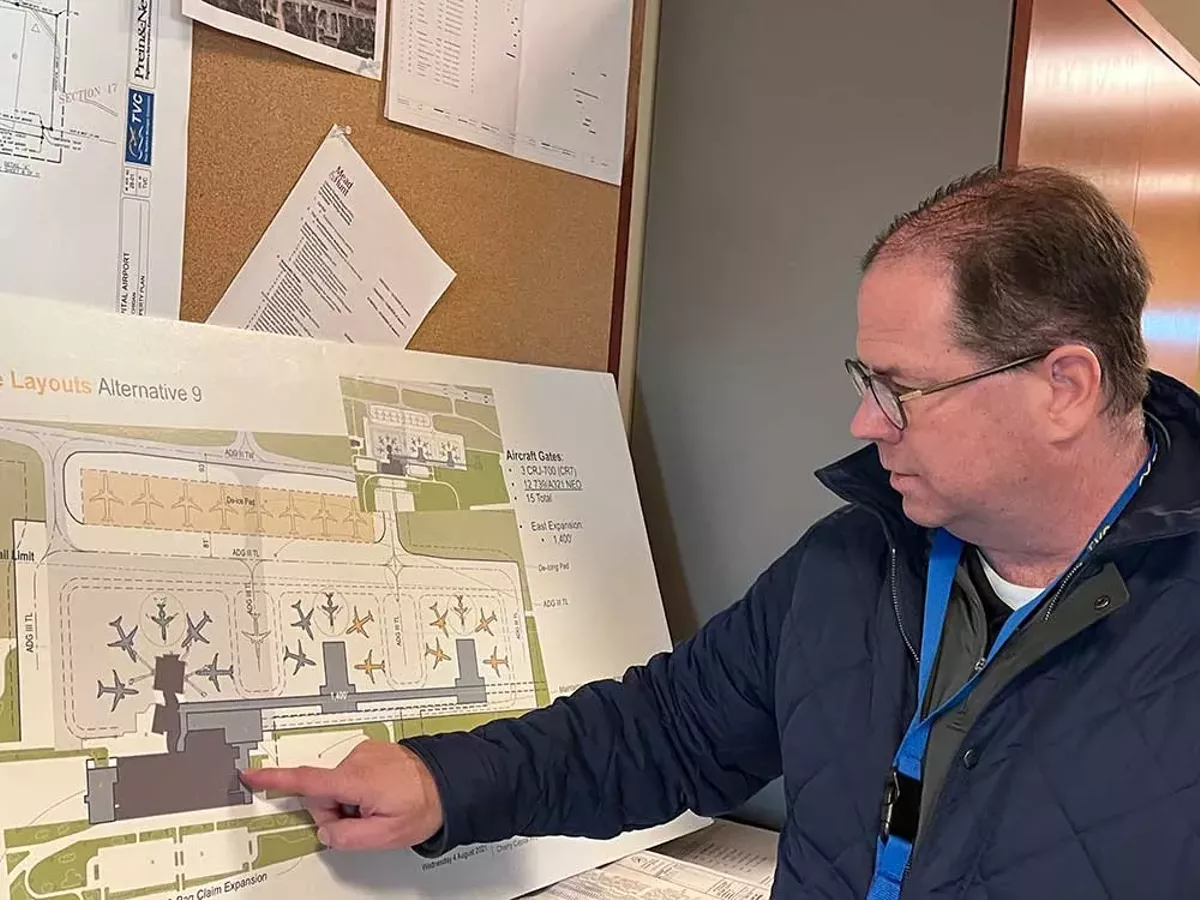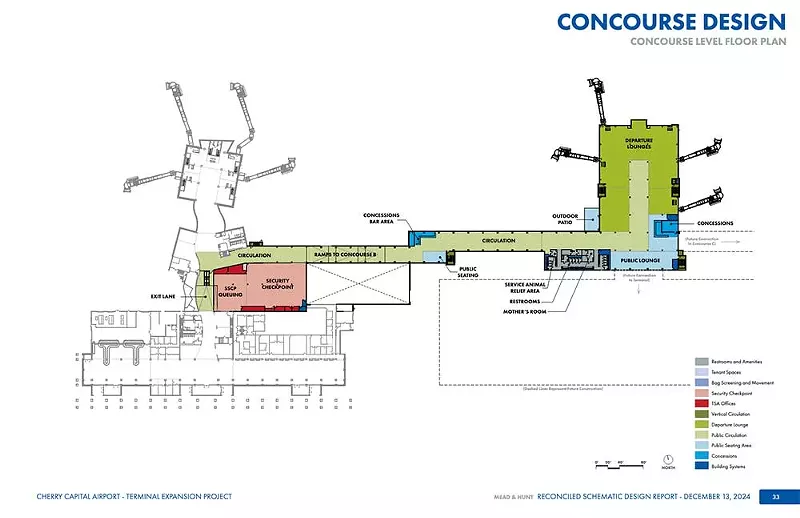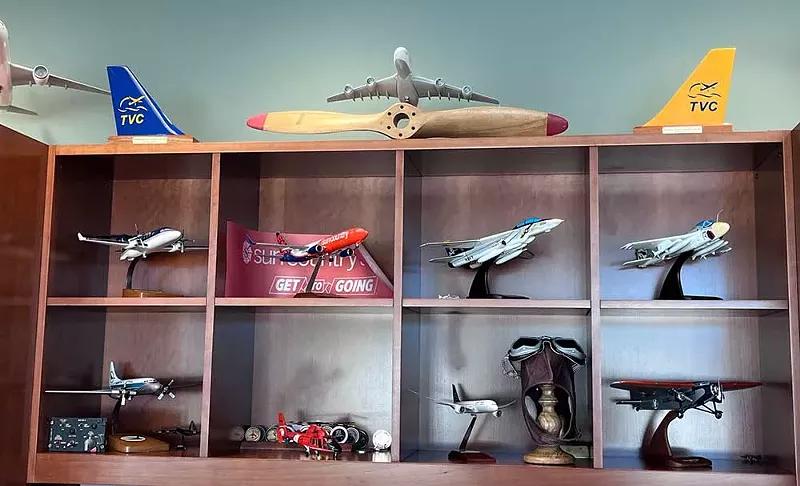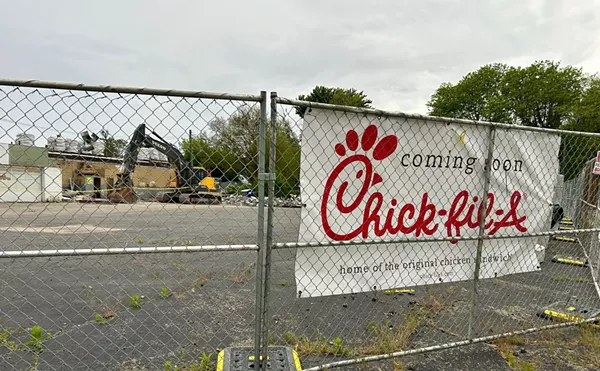As Traverse City’s airport grows, a chance to consider climate
The annual number of travelers has reached about twice what the Cherry Capital Airport was designed to hold


Audio By Carbonatix
[
{
"name": "GPT - Leaderboard - Inline - Content",
"component": "35519556",
"insertPoint": "5th",
"startingPoint": "3",
"requiredCountToDisplay": "3",
"maxInsertions": 100,
"adList": [
{
"adPreset": "LeaderboardInline"
}
]
}
]
This coverage is made possible through a partnership between Interlochen Public Radio and Grist, a nonprofit environmental media organization.
To get to the Cherry Capital Airport in Traverse City, you take a road called “Fly Don’t Drive.” (Get it?)
The airport isn’t crowded on a mid-November morning; the Frank Lloyd Wright-inspired lobby with its fireplace and warm lighting has a few people milling around — none of the hubbub of big terminals.
It usually takes just a few minutes to get through security, and once you’re through and standing in the waiting area, you can see every single gate.
But that calm doesn’t last all year, according to airport CEO Kevin Klein. The airport has become too small to comfortably handle bigger jets with more passengers.
“Today, we’re starting to see aircraft that have 120 seats to almost 200 seats on board,” Klein said. The facility, which opened in 2004, “was not designed to handle that capacity in flux at its peak hour, peak time of day.”
The annual number of travelers has reached about twice what the airport was designed to hold. Klein attributes that to population growth in the region. And even if it’s quiet in the off season, officials say busy summer months can strain the airport’s operations.
“Over the past several years, the present terminal, passenger holding spaces, TSA security, baggage claim, and car rental areas have all experienced significant crowding,” read a letter from the Northwest Regional Airport Authority Board included in a December report on the project.
Bigger planes with more passengers mean that “instead of 250 to 400 passengers waiting in the five-gate terminal holding area in the busy summer season, we can have over 1,000 passengers in that area at any given time,” it continues.

Airport officials want to expand the terminal to meet that demand, with additions including new jet bridges and a new concourse, relocating and expanding the security checkpoint and baggage area, and adding to restrooms, amenities, and concessions.
Klein walked around a grassy field not far from the jet bridges that passengers use to board aircraft. He points out where part of the approximately 68,000-square-foot terminal expansion will go; it won’t expand the airport’s overall property footprint.
Exact plans for the design are 30% done, but the team is considering sustainability, including the building design and materials.
And Klein said there’s a lot of potential; they’re considering everything from fossil fuel consumption — swapping diesel for natural gas — to LED lighting and the building’s air circulation. They’re looking into solar panels. And the design team estimated that upgrades could cut the airport’s water use by 37%.
Designers are factoring in the weight of heavy snow on roofs in the winter and an increase in days hotter than 90 degrees in summer.
The Northwest Regional Airport Authority Board last month approved over $8 million in fundingfor the Traverse City project , but the airport’s plans aren’t set in stone. And as they work through what to do, Klein said they have looked to other airports for examples.
The Gerald R. Ford International Airport in Grand Rapids recently expanded its concourse, and last year was certified through the Airport Carbon Accreditation program, a global effort to assess, manage, and reduce airport emissions.
That airport’s environmental manager Michelle Baker said changes can be tricky. Take the airfield lighting, which they want to change to more energy-efficient LED fixtures: “If you do change lights, for instance, on the airfield, you have to do all of them at the same time in one area, because you don’t want there to be differences between what the pilots see,” she said. “And so there’s a lot of issues with consistency.”
Still, they were able to make their heating, cooling, and lighting more efficient.
“It’s just smart design,” Baker said. “It’s being energy efficient, being, you know, having good water utilization, and being respectful, not only of the planet, but also of the resources that are available.”
They have to do all that while keeping the flying public happy and staying on budget, which is on Kevin Klein’s mind, too. The estimated cost of the Traverse City project is $120 million. Klein said that will be funded through Federal Aviation Administration grants and bonds paid for by user fees.
Other regional airports have grappled with questions of sustainability as well; the FAA has programs to support efforts such as reducing noise and air emissions. Some projects have been funded through the bipartisan infrastructure law, which has been thrown into confusion in the first months of the Trump administration.

Traverse City’s airport was awarded over $11 million of that funding, and Klein said they plan to apply for more grants this year.
Some critics have questioned the expansion. A November opinion piece in the Traverse City Record-Eagle said the airport’s framing of the need for the expansion was misleading, and that the Northwest Regional Airport Authority rushed the approval of the plan. It also warned that local taxpayers could end up footing the bill for bonds if the airport’s plan to leverage new parking fees doesn’t work out.
Looming in the background is the industry’s goal for net-zero emissions by 2050. That would require massive changes and some climate experts are skeptical. The industry makes up between 2 and 3% of carbon emissions globally, and between 9 and 11% of emissions from the U.S. transportation sector.
Along with developing alternative fuels and planes, cutting emissions also involves the airports themselves, since they deal directly with concerns on the ground: noise, traffic, and air pollution.
Andrew Chen, the principal of aviation at the clean energy think tank RMI, said airports have an important role, because they’re essentially landlords for airlines and can leverage that position to push companies to do better.
“So there is a commercial lever that some airports can investigate and try and use further,” he said. “And all of those things can be used to help incentivize airlines using newer aircraft, more fuel efficient aircraft or quieter aircraft at that airport, so that they can help to speed up the overall transition.”
Klein, the Cherry Capital airport CEO, thinks they’ll see more changes in the coming years to an industry that’s “not that old.”
“You’re going to see things change with the aircraft technology,” he said, as well as how people travel, whether regional airport hubs will continue to be viable and whether there will be an increase in nonstop flights.
For now, officials are focused on the terminal expansion at Cherry Capital Airport and hope to break ground next year.
Originally published by Interlochen Public Radio.






